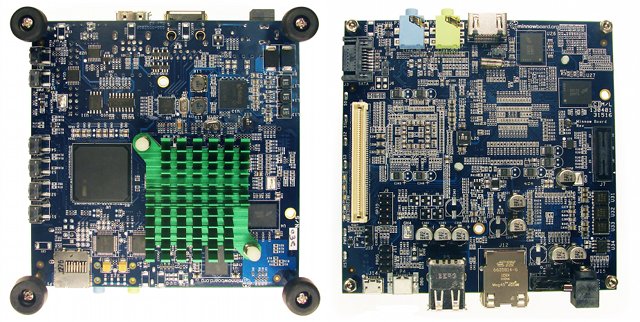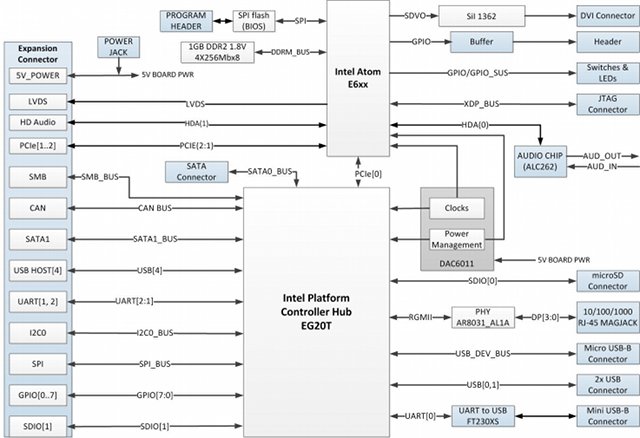Minnowboard is a development board designed by Intel’s Open Source Technology Center, powered by Intel Atom E640 processor @ 1GHz with 1GB RAM, SATA2 and Gigabit Ethernet support, and several embedded I/O such as SPI, I2C and CAN, and that ships with Angstrom Linux distribution.

Minnoboard Specifications:
- Processor – Intel Atom E640 @ 1GHz (32bit)
- Chipset – EG20T Intel Platform Controller Hub
- GPU – Integrated Intel Graphics Media Accelerator (GMA) 600
- System Memory – 1 GB DDR2 RAM
- Storage – 4 MB SPI Flash (for Firmware), micro SD card slot and SATA
- Video Output – SDVO to DVI (over HDMI connector)
- Audio – 1/8″ (3.5mm??) jack line Input and Output
- I/O:
- 1x SATA2 3Gb/sec
- 2x USB host ports + 1x micro USB device
- 1x Serial debug via Serial (UART 0) to USB conversion (mini-USB-B port)
- 10/100/1000 Ethernet
- PCI Express
- Expansions:
- 8x Buffered GPIO pins
- 2x GPIO controlled LEDs
- 4x GPIO switches
- System Firmware Flash Programming Header compatible with Dedi-Prog programmer
- Board Dimensions – 10.67 x 10.67 cm

All software will be provided in binary and source code form, except for the eventual items where they are legally restricted to provide the source code. As mentioned in the introduction the board will run Angström Linux, but it will also be supported by the Yocto Project, and since this is just an x86 platform should be able to run whatever you please on the board. UEFI Firmware (Compliant to the UEFI 2.3. Specification with some 2.3.1 features) will be available for the board in July, and allow things such as fast boot. The hardware files will also be released once hardware development is complete.
Expansion boards called “Lures” that connect via an 100-pin header (See pin description) will be available for the board. Lures will come in 3 different form factors, and currently developed expansion boards include the Beacon Lure (7-Digit Display / EEPROM / LED), Trainer Lure (Arduino compatible board with prototyping area), and LVDS Lure.
If you want to get an idea to what’s possible with the platform, Scott Garman, Embedded Linux Engineer and Technical Evangelist at Intel’s Open Source Technology Center, has uploaded a video showing the board controlling a $100 robotic arm connected with a webcam, which can locate a “fish” on a table with OpenCV, and move it to a plate.
The board is not available yet, but it’s scheduled for July, and currently listed on Mouser, which apparently waits for 500 pieces of the $199 board manufacturer by CircuitCo. It’s one of the rare low cost x86 embedded development boards, and apart from Gizmosphere, I can’t even think of another one. The price seems OK, but it may not look as price/performance competitive as some other boards out there, but according to Darren Hart, who is also involved in the project, the price is such because it must be replicable, so it can’t be subsidized, and parts must have a long product life cycle. Adding support for embedded I/Os also added to cost.
You can find more information on Minnowboard site.

Jean-Luc started CNX Software in 2010 as a part-time endeavor, before quitting his job as a software engineering manager, and starting to write daily news, and reviews full time later in 2011.
Support CNX Software! Donate via cryptocurrencies, become a Patron on Patreon, or purchase goods on Amazon or Aliexpress





Good that the hardware is open, but what about the software ? Why are there parts they cannot open ? Which parts ? What about the boot code? Usually desktop Intel processors verify signatures of firmware so that it can’t be modified, before they even can access RAM. I guess they set up encryption and System Management Mode as infrastructure for DRM or whatever, but it pretty much rules out a 100% free software system. Is it the same for embedded chips ? I don’t remember if GMA600 has free drivers as most of Intel cards or not (as some in some embedded CPUs)
@X
I think they want to make it a platform as open as possible.
Their exact wording on their site is “All software will be provided in image and Open Source form (with binary elements per IP restrictions)”, maybe the way I rephrase that made it worse than it is.
Dammit, again only one S-ATA port. I’m still waiting for a board I can make a RAID 1 with.
Hi all – Scott Garman here from Intel’s Open Source Technology Center. To respond to the questions that have cropped up so far:
The non-open parts of the software are some binary blobs in the UEFI boot firmware and the 3D graphics driver. The UEFI binary bits are low-level hardware routines used at boot time, such as how the memory controller gets initialized. This kind of information is also closed to people when they use a traditional BIOS, so I don’t think that’s going to be a big deal for most folks. The GMA600 can be used in non-accelerated mode with the open source VESA X and framebuffer drivers, but for 3D acceleration, the closed-source EMGD driver will be needed. This was one of the compromises we needed to make to deliver this board with existing hardware. 🙁
m3adow: The board has one SATA port on the motherboard itself, but there is a second SATA port accessible through the Lure expansion interface. So you will eventually be able to buy a Lure that brings out that second SATA port (or even design one yourself!) and be able to create that RAID 1 disk array. Certainly, NAS storage is an application Minnow will be good at given its strong I/O throughput design and Gigabit Ethernet support.
I can be reached at scott dot a dot garman at intel dot com
Minnowboard will start to ship soon from the following vendors:
Digi-Key:
http://www.digikey.com/product-search/en?lang=en&site=us&KeyWords=minnow
Farnell (UK):
http://uk.farnell.com/circuitco/minnowboard/atom-e640t-platform-sbc/dp/2319581
Mouser:
http://www.mouser.com/ProductDetail/CircuitCo/MINNOWBOARD/?qs=HF2YfZwisE9pSS2vIFo6iA%3d%3d
Newark:
http://www.newark.com/circuitco/minnowboard/atom-e640t-platform-sbc/dp/90W0740?Ntt=Minnowboard
You can get more info on the main discussion list for MinnowBoard users and developers: https://groups.google.com/forum/#!forum/minnowboard, #minnowboard IRC channel on Freenode, and http://www.minnowboard.org/community/
Hardware files have been released – http://www.minnowboard.org/technical-features/
@m3adow
Google “backplane with PCIe and sata”